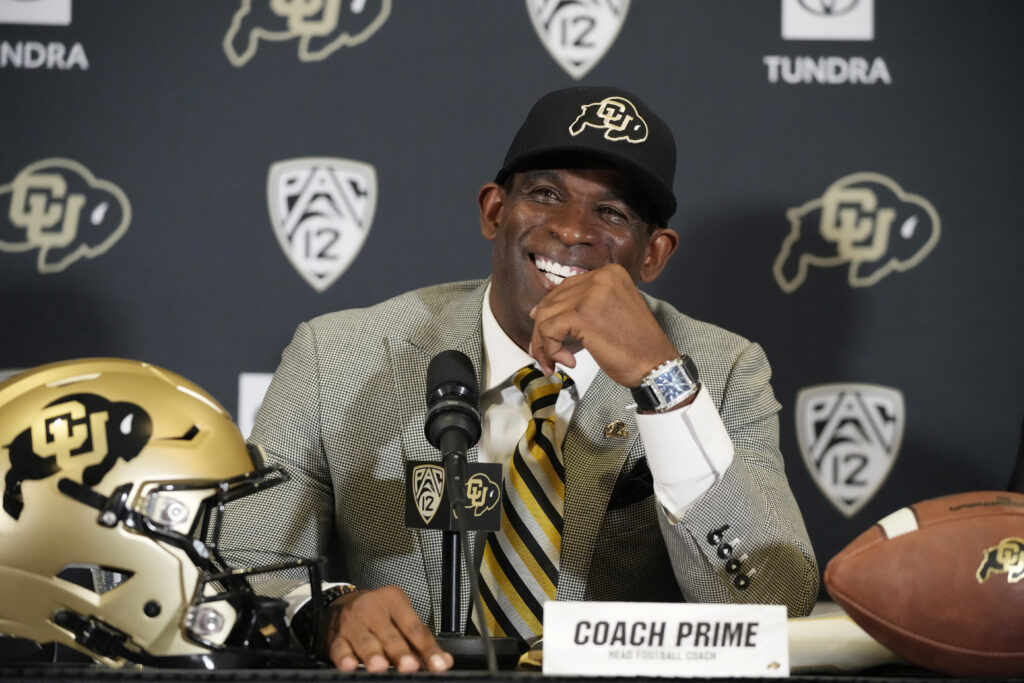One event, two athletic directors and an immeasurable difference in public commitments encapsulated the Pac-12’s wobbly present.
There was Utah’s Mark Harlan, sharing the main stage with commissioner George Kliavkoff late last week at the preseason media extravaganza in Las Vegas. Harlan fielded questions from the reporters and, in the process, doubled down on Utah’s allegiance.
“Our words and actions speak for themselves,” he said. “We are proud members of this conference.”
A few hours later, Colorado’s Rick George took the same stage for a 15-minute panel discussion on the College Football Playoff, then declined to take questions as he scurried out the rear exit.
“I’ve got a flight to catch,” he said.
Utah and Colorado joined the Pac-12 on the same day, July 1, 2011. By all accounts, the Utes are committed to a future in the conference despite the protracted media rights negotiations that have frustrated fans and campus officials alike.
But Colorado’s status isn’t as clear in the public sphere, with speculation swirling that the university could depart for the Big 12 as early as this week — a move that some believe would trigger an exodus and decimate the century-old league.
Would the Buffaloes leave for the Big 12 even if the annual broadcast revenue from ESPN and Fox ($31.7 million per school per year) is comparable to what they stand to earn in the Pac-12?
Would they accept an invitation from the Big 12 before seeing an official offer on the table in the Pac-12?
The Hotline won’t claim to know how the saga within a saga will end (or when it will end). Instead, this exercise is intended to illuminate the issues at the heart of Colorado’s decision — issues that are as unique as CU’s geography.
For all the uncertainty, three things are apparent:
1. Realignment rumors and grapevine position move in lockstep.
The closer your position to the front lines of college football — the space occupied by fans, media, coaches and even athletic directors — the more fervent the speculation that Colorado is prepared to leave the Pac-12.
But reverse course and head toward the ivory towers, where Colorado chancellor Phil DiStefano and his nine colleagues are in regular discussions about the Pac-12’s future, and the noise seems to subside.
2. Colorado’s situation is as complex as the map is simple.
The campus is not located on the West Coast or fixed in the Pacific Time Zone (even for half the year). In fact, it’s 200 miles closer to Dallas than Los Angeles. The school was in the Big Eight/Big 12 for 62 years and has been a member of the Pac-12 for just 12.
Yet in vibe, culture and politics, Boulder is more California than Texas, more West Coast than Southern Plains.
3. Colorado’s identity is at stake in realignment, but which identity?
The decision to remain in the Pac-12 or return to the Big 12 illuminates the university’s quest to define itself athletically and academically. What’s best for one might not be best for the other.
Athletically, a connection to Texas, to a greater extent than even California, is necessary for CU’s football recruiting. And there are more blue-chip prospects in the former than the latter: 63 per year in Texas compared to 33 annually in California. (Details below).
The power structure within Boulder reflects the potential for a Big 12 lean, as well.
Coach Deion Sanders, who has transformed the Buffaloes’ national profile since his appointment last winter, views the Lone Star State as imperative. Meanwhile, the chancellor, DiStefano, and athletic director, George, are nearing retirement. Their legacies are at stake.
Will they be swayed by Sanders? What are their priorities? Where are their loyalties? How deep are the scars from the Pac-12’s many missteps under former commissioner Larry Scott?
But when it comes to issues that impact the university in totality, including both the source and mouth of Colorado’s enrollment pipeline, the school seems more suited for the West Coast.
— The source: Colorado welcomed 36,000 students in the fall of 2022, according to the university’s office of data analytics, and slightly more than half (56 percent) were in-state residents.
The out-of-state student population tilts heavily to California. The Golden State is CU’s golden ticket — hello, full-cost tuition! — and accounts for 10 percent of the school’s total enrollment.
There are three times as many students from California as those from Texas.
— The mouth: Colorado has approximately 300,000 living alumni, according to the university. About 50 percent reside in Colorado, while the out-of-state alumni base tilts substantially to Northern and Southern California specifically and the West Coast generally.
There are more alumni in San Francisco than Colorado Springs, more in Seattle than Dallas.
Donations to the athletic department from California increased 903 percent during CU’s first four seasons in the Pac-12, the Boulder Daily Camera reported in 2015.
“Where we play is taking us to where our people are,” George said at the time.
(Note: The alumni data cited above is from 2016.)
— Were conference affiliation tied solely to academic prestige, the Buffaloes wouldn’t consider switching conferences.
Average U.S. News and World Report ranking of Pac-12 schools in 2022-23 (excluding Colorado): 97th
Average ranking of Big 12 schools: 148th
(Full list below.)
Number of Pac-12 schools in the Association of American Universities (excluding Colorado): 7
Number of Big 12 schools in the Association of American Universities: 1
And yet, here we are.
A dozen years after Colorado shifted its center of gravity from Texas to California, speculation is rampant that the Buffaloes will reverse course.
In that time, they have zero Pac-12 football titles, just two bowl appearances and a winning percentage of 26.2 in conference games.
Are their struggles on the field related to conference affiliation, questionable coaching hires or resources available? Would the Buffaloes have performed any better in the Big 12 over the past decade? Their final chapter in that league, in the mid-to-late 2000s, was littered with defeat, as well.
Athletically, the school feels forever adrift … not textbook Big 12 but not classic Pac-12 … reliant upon the Southern Plains and the West Coast for roster building … tied to its athletic past in a Texas-based league and to its institutional present in a California-centric conference …
Contiguous to two Power Five leagues but ideally built, it seems, for none.
Number of four- and five-star prospects based on 247 Sports ratings
2020 (current college seniors)
Texas: 55
California: 32
2021 (juniors)
Texas: 54
California: 34
2022 (sophomores)
Texas: 60
California: 30
2023 (freshmen)
Texas: 71
California: 34
2024 (high school seniors)
Texas: 72
California: 36
Total/average
Texas: 312/62.4
California: 166/33.2
U.S. News rankings of national universities (2022-23)
*** Pac-12 (excluding L.A. schools and Colorado):
3. Stanford
20. Cal
55. Washington
105. (tie) Arizona
105. (tie) Oregon
105. (tie) Utah
121. (tie) Arizona State
151. Oregon State
212. Washington State
Conference average: 97
*** Big 12 (excluding Texas and Oklahoma but including new members):
77. Baylor
89. Brigham Young
89. TCU
121. (tie) Kansas
127. Iowa State
137. UCF
151. Cincinnati
166. Kansas State
182. Oklahoma State
182. Houston
219. Texas Tech
234. West Virginia
Conference average: 148th
Members of the Association of American Universities
*** Pac-12 (excluding Colorado): 7 (Arizona, Arizona State, Cal, Stanford, Oregon, Utah and Washington)
*** Big 12: 1 (Kansas)
*** Send suggestions, comments and tips (confidentiality guaranteed) to pac12hotline@bayareanewsgroup.com or call 408-920-5716
*** Follow me on Twitter: @WilnerHotline
*** Pac-12 Hotline is not endorsed or sponsored by the Pac-12 Conference, and the views expressed herein do not necessarily reflect the views of the Conference.
Related posts:

(AP Photo/Ralph Freso, File)
Hotline mailbag: An SEC feud, the Pac-12 villain vacancy, the FCG switch, schedule options and more Wilner Mailbag -DEFCON 1 realignment scenario, should Oregon, Washington, UCLA and USC leave the conference?
Wilner Mailbag -DEFCON 1 realignment scenario, should Oregon, Washington, UCLA and USC leave the conference?

(AP Photo/Marcio Jose Sanchez)
Business of Sports – Updated Power Five revenue projections show Pac-12 deficit expanding as COVID hits, ACC Network grows and Big Ten, SEC rake in the cash
(Michael Malone/Bay Area News Group)
Wilner Hotline – Pac-12 to jump-start media rights negotiations after thunderbolt from Los AngelesJon Wilner
Jon Wilner has been covering college sports for decades and is an AP top-25 football and basketball voter as well as a Heisman Trophy voter. He was named Beat Writer of the Year in 2013 by the Football Writers Association of America for his coverage of the Pac-12, won first place for feature writing in 2016 in the Associated Press Sports Editors writing contest and is a five-time APSE honoree.
